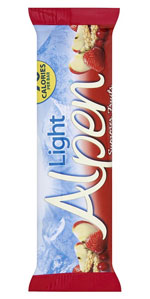 Ingredients
Ingredients-
- Cereals (wheat, oats, rice) 42%
- Oligofructose 30%
- Apple pieces and apple juice concentrate 6.5%
- Strawberries, raspberries and cranberries 3.5%
- Sugar
- Glycerol
- Sulphur dioxide
- Glucose syrup
- Vegetable oil
- Dextrose
- Wheat gluten
- Malted barley extract
- Milk lactose
- Milk yogurt powder
- Salt
- Maize starch
- Flavourings
- Skimmed milk powder
- Milk whey powder
- Defatted wheat germ
- Citric acid
- Lecithin
- Malic acid
- Tocopherol
Published March 2011
This is a tasty snack bar which does not provide much in the way of sugar, fats or salt, and contains 'less than 70 calories per bar'. It includes many ingredients that the reader will understand, so what follows is an explanation of those ingredients which they may be less familiar with and which are shown in blue in the list above.
Ingredients
Oligofructose is a carbohydrate consisting of a short chain of linked fructose units. Fructose is a simple sugar (C6H12O6) with a very sweet taste and a major component of treacle and honey. Oligofructose is not broken down by enzymes in the stomach so it is not absorbed, but it passes into the intestines to provide food for beneficial bacteria. These are then encouraged to multiply and so crowd out harmful bacteria - in theory.
Glycerol (aka glycerine, E422, chemical formula HOCH2CH(OH)CH2OH) is the humectant and there to keep the bar moist as well as being sweet tasting. There is currently a world glut of glycerol because it is a by-product of the manufacture of biodiesel.
Sulphur dioxide (SO2) is the gas blamed for causing acid rain and it originates from the sulphur in fossil fuels. It is also the gas used to manufacture sulphuric acid, the largest volume chemical used by industry. Sulphur dioxide has been used in the production of wine since Roman times and they produced in by burning sulfur itself. Dissolved in water, SO2 acts as a preservative for fruit. Some people are particularly sensitive to it and if they drink new wines or eat dried fruit it can cause asthma because it restricts the windpipe (the trachea).
Dextrose is another name for D-glucose as used in processed foods. Its name comes from dextrorotatory glucose (dextra = right-handed) and this is the glucose produced by plants and which can be digested easily.
Lecithin (E322) is an emulsifier and the one used here is extracted from soya. Lecithin consists of two long-chain fatty acids bonded to phosphate, which also has choline attached. (Choline is an essential nutrient and has a role to play as a molecular messenger.) Lecithin has applications in pharmaceuticals, plastics, inks and paints. It acts as a dispersant in inks and paints by preventing the pigment suspended in the liquid from settling out.
Malic acid (E296, chemical formula HO2CCH2CH(OH)CO2H) is the acid of unripe fruits and particularly of unripe apples. It is the acid tang of Salt and Vinegar crisps. Here is it acting to regulate the overall acid level within the bar. Malic acid is used to clean teeth before they are filled and it is the acid used in some forms of skin treatments (aka 'chemical peels') in which the top layer of skin is peeled away to reveal new and more youthful looking skin beneath.
Tocopherol (E307, chemical formula C29H50O2) is a form of vitamin E and a powerful antioxidant. It is added to lots of cosmetics in the belief that it can neutralise the free radicals which some believe are the main cause of skin ageing.